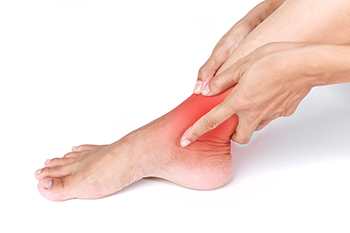Items filtered by date: April 2022
Arthritis Can Cause Pain in the Feet and Ankles
Facts About Arthritis

Arthritis has long been considered an ailment of the elderly, but a variety of other people are actually experiencing some form of arthritis, even children. Arthritis is an inflammation of the joints that produces pain, swelling, and muscle stiffness that often affect the toes, feet, and ankles. Among the causes are the deterioration of cartilage that then endangers the bones, an attack of the autoimmune system, smoking, previous injury, over-exercising or repetitive stress, serious infections, and heredity. There are many types of arthritis, including rheumatoid, psoriatic, osteoarthritis, fibromyalgia, gout, ankylosing spondylitis, lupus and juvenile. The most easily recognizable symptoms of arthritis include pain and swelling in the joints, redness, difficulty in walking or moving the joints, stiffness in the morning, and tenderness to the touch. Many treatments are available that allow you to live with this condition. If you think you or your child may have arthritis, it is a good idea to contact a podiatrist for a complete examination and diagnosis, as well as possible treatment plans.
Arthritis can be a difficult condition to live with. If you are seeking treatment, contact one of our podiatrists from In Motion Foot and Ankle. Our doctors can provide the care you need to keep you pain-free and on your feet.
Arthritic Foot Care
Arthritis is a joint disorder that involves the inflammation of different joints in your body, such as those in your feet. Arthritis is often caused by a degenerative joint disease and causes mild to severe pain in all affected areas. In addition to this, swelling and stiffness in the affected joints can also be a common symptom of arthritis.
In many cases, wearing ill-fitting shoes can worsen the effects and pain of arthritis. Wearing shoes that have a lower heel and extra room can help your feet feel more comfortable. In cases of rheumatoid arthritis, the arch in your foot may become problematic. Buying shoes with proper arch support that contour to your feet can help immensely.
Alleviating Arthritic Pain
- Exercises that stretch the foot can prevent further pain and injury and increase mobility
- Most of the pain can be alleviated with anti-inflammatory drugs, heat, and topical medications
- Massages can help temporarily alleviate pain.
It is best to see your doctor for the treatment that is right for your needs and symptoms. Conditions vary, and a podiatrist can help you determine the right method of care for your feet.
If you have any questions, please feel free to contact our offices located in Cypress and Houston, TX . We offer the newest diagnostic tools and technology to treat your foot and ankle needs.
Why Your Ankle May Hurt Without an Injury

Ankle pain that is sudden, and not due to an injury, may be caused by any number of causes, including certain arthritic conditions. Rheumatoid arthritis and osteoarthritis can sometimes negatively affect the tissue and cartilage (respectively) in ankles, causing pain and swelling. Similar symptoms can be present when reactive arthritis affects the ankle. This is a condition which is triggered by a bacterial infection elsewhere in the body. Gout is another type of arthritis in which excessive amounts of uric acid crystalize on joints. Gout usually affects the big toe, but it can also affect the ankle. Another disease that sometimes affects the ankle joint causing stiffness, pain and swelling is scleroderma. Bursitis is a condition in which the cushioning bursa sac at the back of the ankle becomes inflamed from stress or overuse and produces pain and inflammation. If you rupture or tear the tendon that connects your calf muscle with your heel (Achilles tendon), you can develop a condition known as Achilles tendonitis. These are just a few of the conditions that may cause ankle pain without injury. Whatever the cause, it is important to have your ankle pain properly diagnosed in order to receive the proper treatment. Call a podiatrist if you are experiencing any pain in your ankle.
Ankle pain can be caused by a number of problems and may be potentially serious. If you have ankle pain, consult with one of our podiatrists from In Motion Foot and Ankle. Our doctors will assess your condition and provide you with quality foot and ankle treatment.
Ankle pain is any condition that causes pain in the ankle. Due to the fact that the ankle consists of tendons, muscles, bones, and ligaments, ankle pain can come from a number of different conditions.
Causes
The most common causes of ankle pain include:
- Types of arthritis (rheumatoid, osteoarthritis, and gout)
- Ankle sprains
- Broken ankles
- Achilles tendinitis
- Achilles tendon rupture
- Stress fractures
- Bursitis
- Tarsal tunnel syndrome
- Plantar fasciitis
Symptoms
Symptoms of ankle injury vary based upon the condition. Pain may include general pain and discomfort, swelling, aching, redness, bruising, burning or stabbing sensations, and/or loss of sensation.
Diagnosis
Due to the wide variety of potential causes of ankle pain, podiatrists will utilize a number of different methods to properly diagnose ankle pain. This can include asking for personal and family medical histories and of any recent injuries. Further diagnosis may include sensation tests, a physical examination, and potentially x-rays or other imaging tests.
Treatment
Just as the range of causes varies widely, so do treatments. Some more common treatments are rest, ice packs, keeping pressure off the foot, orthotics and braces, medication for inflammation and pain, and surgery.
If you have any questions, please feel free to contact our offices located in Cypress and Houston, TX . We offer the newest diagnostic and treatment technologies for all your foot care needs.
Potential Causes for Sprained Ankles
 People who unexpectedly twist their foot may experience a sprained ankle, which occurs as a result of overstretching the muscles, tendons and ligaments. The symptoms that often accompany a sprained ankle can include bruising, swelling, and difficulty moving the ankle. People who have weak ankles may be more susceptible to a sprain. It can help to improve ankle strength by performing specific exercises that are designed for the ankles. Additionally, it is a good idea to do warm up and cool down stretches before and after working out. Research has indicated it is beneficial to lose any extra weight in order to lessen the pressure that is exerted on the ankles. There are several treatment options for sprained ankles, and it is suggested that you consult with a podiatrist who can determine which one is the best for you.
People who unexpectedly twist their foot may experience a sprained ankle, which occurs as a result of overstretching the muscles, tendons and ligaments. The symptoms that often accompany a sprained ankle can include bruising, swelling, and difficulty moving the ankle. People who have weak ankles may be more susceptible to a sprain. It can help to improve ankle strength by performing specific exercises that are designed for the ankles. Additionally, it is a good idea to do warm up and cool down stretches before and after working out. Research has indicated it is beneficial to lose any extra weight in order to lessen the pressure that is exerted on the ankles. There are several treatment options for sprained ankles, and it is suggested that you consult with a podiatrist who can determine which one is the best for you.
Ankle sprains are common but need immediate attention. If you need your feet checked, contact one of our podiatrists from In Motion Foot and Ankle. Our doctors can provide the care you need to keep you pain-free and on your feet.
How Does an Ankle Sprain Occur?
Ankle sprains take place when the ligaments in your ankle are torn or stretched beyond their limits. There are multiple ways that the ankle can become injured, including twisting or rolling over onto your ankle, putting undue stress on it, or causing trauma to the ankle itself.
What Are the Symptoms?
- Mild to moderate bruising
- Limited mobility
- Swelling
- Discoloration of the skin (depending on severity)
Preventing a Sprain
- Wearing appropriate shoes for the occasion
- Stretching before exercises and sports
- Knowing your limits
Treatment of a Sprain
Treatment of a sprain depends on the severity. Many times, people are told to rest and remain off their feet completely, while others are given an air cast. If the sprain is very severe, surgery may be required.
If you have suffered an ankle sprain previously, you may want to consider additional support such as a brace and regular exercises to strengthen the ankle.
If you have any questions please feel free to contact our offices located in Cypress and Houston, TX . We offer the newest diagnostic and treatment technologies for all your foot and ankle needs.
Where Is the Cuboid Bone Located?
 The cuboid bone is one of seven tarsal bones that are located in the foot. This particular bone is found on the outside of the foot, near the front of the ankle, and this is where pain is felt when the cuboid bone becomes dislocated. It can happen as a result of enduring a break or sprain, and it often causes pain and discomfort. Relief may be found when the affected area is massaged, and a podiatrist may manipulate the cuboid bone back into its normal position. Some patients find it beneficial to wear specific shoes that can help the foot to feel better, in addition to taping the foot for stability. If you have pain in this part of your foot, it is strongly suggested that you speak with a podiatrist as quickly as possible who can offer you correct treatment solutions for cuboid syndrome.
The cuboid bone is one of seven tarsal bones that are located in the foot. This particular bone is found on the outside of the foot, near the front of the ankle, and this is where pain is felt when the cuboid bone becomes dislocated. It can happen as a result of enduring a break or sprain, and it often causes pain and discomfort. Relief may be found when the affected area is massaged, and a podiatrist may manipulate the cuboid bone back into its normal position. Some patients find it beneficial to wear specific shoes that can help the foot to feel better, in addition to taping the foot for stability. If you have pain in this part of your foot, it is strongly suggested that you speak with a podiatrist as quickly as possible who can offer you correct treatment solutions for cuboid syndrome.
Cuboid syndrome, also known as cuboid subluxation, occurs when the joints and ligaments near the cuboid bone in the foot become torn. If you have cuboid syndrome, consult with one of our podiatrists from In Motion Foot and Ankle. Our doctors will assess your condition and provide you with quality foot and ankle treatment.
Cuboid syndrome is a common cause of lateral foot pain, which is pain on the outside of the foot. The condition may happen suddenly due to an ankle sprain, or it may develop slowly overtime from repetitive tension through the bone and surrounding structures.
Causes
The most common causes of cuboid syndrome include:
- Injury – The most common cause of this ailment is an ankle sprain.
- Repetitive Strain – Tension placed through the peroneus longus muscle from repetitive activities such as jumping and running may cause excessive traction on the bone causing it to sublux.
- Altered Foot Biomechanics – Most people suffering from cuboid subluxation have flat feet.
Symptoms
A common symptom of cuboid syndrome is pain along the outside of the foot which can be felt in the ankle and toes. This pain may create walking difficulties and may cause those with the condition to walk with a limp.
Diagnosis
Diagnosis of cuboid syndrome is often difficult, and it is often misdiagnosed. X-rays, MRIs and CT scans often fail to properly show the cuboid subluxation. Although there isn’t a specific test used to diagnose cuboid syndrome, your podiatrist will usually check if pain is felt while pressing firmly on the cuboid bone of your foot.
Treatment
Just as the range of causes varies widely, so do treatments. Some more common treatments are ice therapy, rest, exercise, taping, and orthotics.
If you have any questions, please feel free to contact our offices located in Cypress and Houston, TX . We offer the newest diagnostic and treatment technologies for all your foot care needs.

